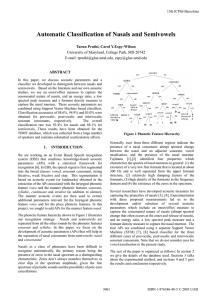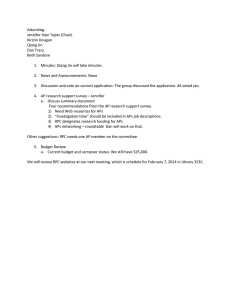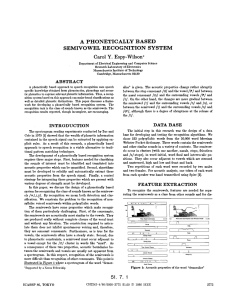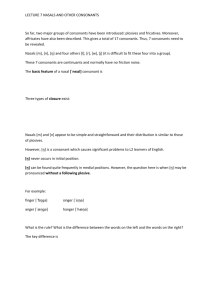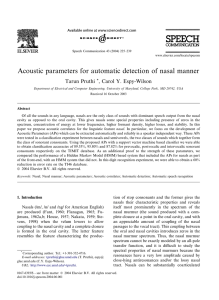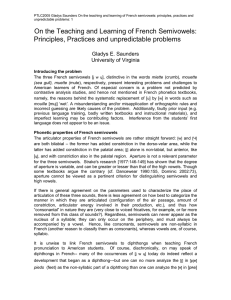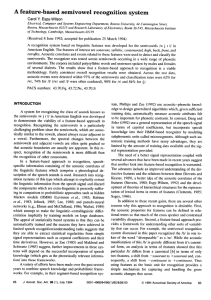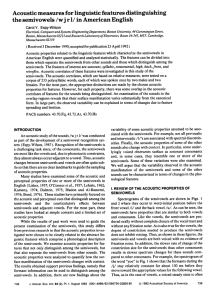Acoustic Parameters for Automatic Detection of Nasal Manner
advertisement
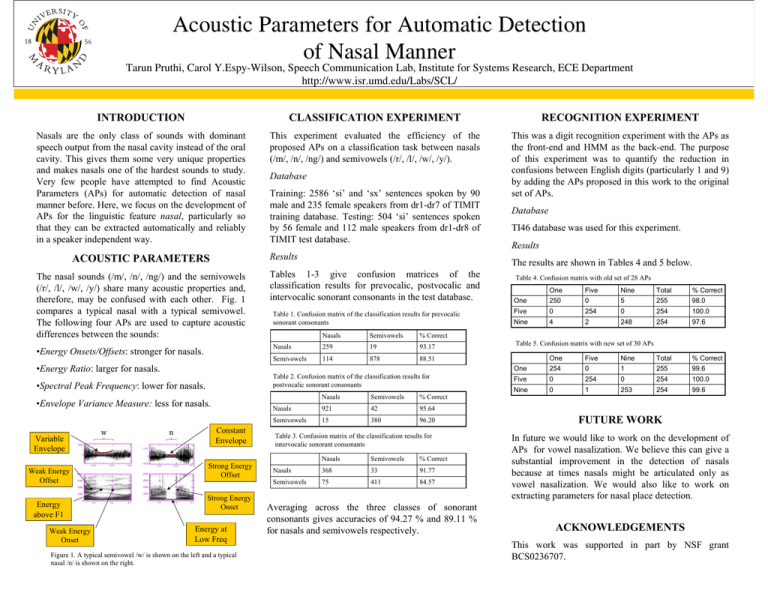
Acoustic Parameters for Automatic Detection of Nasal Manner Tarun Pruthi, Carol Y.Espy-Wilson, Speech Communication Lab, Institute for Systems Research, ECE Department http://www.isr.umd.edu/Labs/SCL/ INTRODUCTION CLASSIFICATION EXPERIMENT RECOGNITION EXPERIMENT Nasals are the only class of sounds with dominant speech output from the nasal cavity instead of the oral cavity. This gives them some very unique properties and makes nasals one of the hardest sounds to study. Very few people have attempted to find Acoustic Parameters (APs) for automatic detection of nasal manner before. Here, we focus on the development of APs for the linguistic feature nasal, particularly so that they can be extracted automatically and reliably in a speaker independent way. This experiment evaluated the efficiency of the proposed APs on a classification task between nasals (/m/, /n/, /ng/) and semivowels (/r/, /l/, /w/, /y/). This was a digit recognition experiment with the APs as the front-end and HMM as the back-end. The purpose of this experiment was to quantify the reduction in confusions between English digits (particularly 1 and 9) by adding the APs proposed in this work to the original set of APs. Database Training: 2586 ‘si’ and ‘sx’ sentences spoken by 90 male and 235 female speakers from dr1-dr7 of TIMIT training database. Testing: 504 ‘si’ sentences spoken by 56 female and 112 male speakers from dr1-dr8 of TIMIT test database. Results ACOUSTIC PARAMETERS The nasal sounds (/m/, /n/, /ng/) and the semivowels (/r/, /l/, /w/, /y/) share many acoustic properties and, therefore, may be confused with each other. Fig. 1 compares a typical nasal with a typical semivowel. The following four APs are used to capture acoustic differences between the sounds: •Energy Onsets/Offsets: stronger for nasals. Table 1. Confusion matrix of the classification results for prevocalic sonorant consonants Nasals Semivowels % Correct Nasals 259 19 93.17 Semivowels 114 878 88.51 Table 2. Confusion matrix of the classification results for postvocalic sonorant consonants Nasals •Envelope Variance Measure: less for nasals. Variable Envelope Weak Energy Offset Energy above F1 Weak Energy Onset w n Constant Envelope Strong Energy Offset Strong Energy Onset Energy at Low Freq Figure 1. A typical semivowel /w/ is shown on the left and a typical nasal /n/ is shown on the right. TI46 database was used for this experiment. Results The results are shown in Tables 4 and 5 below. Tables 1-3 give confusion matrices of the classification results for prevocalic, postvocalic and intervocalic sonorant consonants in the test database. •Energy Ratio: larger for nasals. •Spectral Peak Frequency: lower for nasals. Database Semivowels Table 4. Confusion matrix with old set of 28 APs One One Five Nine Total % Correct 250 0 5 255 98.0 Five 0 254 0 254 100.0 Nine 4 2 248 254 97.6 Table 5. Confusion matrix with new set of 30 APs One Five Nine Total % Correct One 254 0 1 255 99.6 Five 0 254 0 254 100.0 Nine 0 1 253 254 99.6 % Correct Nasals 921 42 95.64 Semivowels 15 380 96.20 Table 3. Confusion matrix of the classification results for intervocalic sonorant consonants Nasals Semivowels Nasals 368 33 % Correct 91.77 Semivowels 75 411 84.57 Averaging across the three classes of sonorant consonants gives accuracies of 94.27 % and 89.11 % for nasals and semivowels respectively. FUTURE WORK In future we would like to work on the development of APs for vowel nasalization. We believe this can give a substantial improvement in the detection of nasals because at times nasals might be articulated only as vowel nasalization. We would also like to work on extracting parameters for nasal place detection. ACKNOWLEDGEMENTS This work was supported in part by NSF grant BCS0236707.
